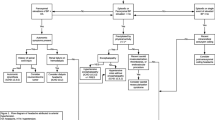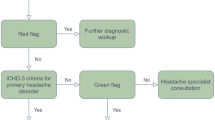Abstract
Young patients with migraine are at increased risk for stroke, particularly patients with an aura of focal neurologic deficits. Other causes of ischemia are often identified in patients with migraine, including patent foramen ovale, lupus anticoagulant, cervical carotid dissection, arteriovenous malformation, and hyperactivity of the clotting system. Migrainous stroke is only diagnosed when all other possible causes of stroke have been eliminated and the patient has irreversibility of the usual aura, associated with an ischemic infarct in the appropriate brain territory. Prophylactic therapy of migraine with aura may be beneficial in preventing migrainous stroke.
Similar content being viewed by others
References and Recommended Reading
Teive HAG, Kowacs PA, Maranhao F, et al.: Leao’s cortical spreading depression. From experimental “artifact” to physiological principle. Neurology 2005, 65:1455–1459.
Waeber C, Moskowitz MA: Migraine as an inflammatory disorder. Neurology 2005, 64:S9–S15.
Kruit MC, Launer LJ, Ferrari MD, van Buchem MA: Infarcts in the posterior circulation territory in migraine. The population-based MRI CAMERA study. Brain 2005, 128:2068–2077.
Kruit MC, van Buchem MA, Hofman PA, et al.: Migraine as a risk factor for subclinical brain lesions. JAMA 2004, 291:427–434.
Welch KMA: Relationship of stroke and migraine. Neurology 1994, 44(Suppl 7):S33–S36.
Bousser M-G, Welch MA: Relation between migraine and stroke. Lancet Neurol 2005, 4:533–542.
Rothrock JF, Walicke P, Swenson MR, et al.: Migrainous stroke. Arch Neurol 1988, 45:63–67.
Rothrock J, North J, Madden K, et al.: Migraine and migrainous stroke: risk factors and prognosis. Neurology 1993, 43:2473–2476.
Chabriat H, Joutel K, Vahedi E, et al.: CADASIL. Cerebral autosomal dominant arteriopathy with subcortical infarcts and leukoencephalopathy. In Stroke: Pathophysiology, Diagnosis and Management. Edited by Mohr JP, Choi DW, Grotta JC, et al.: Philadelphia: Churchill Livingstone; 2004:687–692.
Hirano M, Pavlakis SG: Mitochondrial myopathy, encephalopathy, lactic acidosis and strokelike episodes (MELAS): current concepts. J Child Neurol 1994, 9:4–13.
Diener HC, Weimar C, Katsarava Z: Patent foramen ovale: paradoxical connection to migraine and stroke. Curr Opin Neurol 2005, 18:299–304.
Schwerzmann M, Nedeltchev K, Lagger F, et al.: Prevalence and size of directly detected patent foramen ovale in migraine with aura. Neurology 2005, 65:145–1418.
Anzola GP, Morandi E, Casilli F, Onorato E: Different degrees of right-to-left shunting predict migraine and stroke: Data from 420 patients. Neurology 2006, 66:765–767.
Olesen J, Larsen B, Lauritzen M: Focal hyperemia followed by spreading oligemia and impaired activation of rCBF in classic migraine. Ann Neurol 1981, 9:344–352.
Buzzi MG, Moskowitz MA: The pathophysiology of migraine: year 2005. J Headache Pain 2005, 6:105–111.
Bolay H, Reuter U, Dunn AK, et al.: Intrinsic brain activity triggers trigeminal meningeal afferents in a migraine model. Nat Med 2002, 8:136–142.
Olesen J, Diener H-C, Husstedt JW, et al.: Calcitonin gene-related peptide receptor antagonist BIBN 4096 BS for the acute treatment of migraine. N Engl J Med 2004, 350:1104–1110.
Ayata C, Kudo JH, Dalkara T, Moskowitz MA: Suppression of cortical spreading depression in migraine prophylaxis. Ann Neurol 2006, 59:652–661.
Durcros A, Diener H-C, Joutel A, et al.: The clinical spectrum of familial hemiplegic migraine associated with mutations in a neuronal calcium channel. N Engl J Med 2001, 345:17–24.
Thomsen LL, Eriksen MK, Romer SF, et al.: An epidemiological survey of hemiplegic migraine. Cephalalgia 2002, 22:361–375.
Stang PE, Carson AP, Rose KM, et al.: Headache, cerebrovascular symptoms and stroke. The Atherosclerosis Risk in Communities Study. Neurology 2005, 64:1573–1577.
Kurth T, Slomke MA, Kase CS, et al.: Migraine, headache, and the risk of stroke in women. A prospective study. Neurology 2005, 64:1020–1026.
Buring JE, Hebert P, Romero J, et al.: Migraine and subsequent risk of stroke in the Physicians’ Health Study. Arch Neurol 1995, 52:129–134.
Merikangas KR, Fenton BT, Cheng SH, et al.: Association between migraine and stroke in a large-scale epidemiological study of the United States. Arch Neurol 1997, 54:362–368.
Chang CL, Donaghy M, Poulter N: World Health Organisation Collaborative Study of Cardiovascular Disease and Steroid Hormone Contraception. Migraine and stroke in young women: case-control study. Br Med J 1999, 318–318.
Nightingale AL, Farmer RDT: Ischemic stroke in young women: A nested case-control study using the UK general practice research database. Stroke 2004, 35:1574–1578.
Milhaud D, Bogousslavsky J, van Melle G, Liot P: Ischemic stroke and active migraine. Neurology 2001, 57:1805–1811.
Mosek A, Marom R, Korczyn AD, Bornstein N: A history of migraine is not a risk factor to develop and ischemic stroke in the elderly. Headache 2001, 41:399–401.
Kittner SJ, Stern BJ, Wozniak M, Buchholz DW, et al.: Cerebral infarction in young adults: the Baltimore-Washington cooperative young stroke study. Neurology 1998, 50:890–894.
Gillum LA, Mamidipudi SK, Johnston SC: Ischemic stroke risk with oral contraceptives. A meta-analysis. JAMA 2000, 284:72–78.
Bousser M-G, Kittner SJ: Oral contraceptives and stroke. Cephalalgia 2000, 20:183–189.
Tzourio C, Tehindrazanarivelo A, Iglesias S: Case-control study of migraine and risk of ischaemic stroke in young women. Br Med J 1995, 310:830–833.
Bousser M-G, Conard J, Kittner S, et al.: The International Headache Society Task Force on Combined Oral Contraceptives and Hormon Replacement Therapy. Recommendations on the risk of ischaemic stroke associated with use of combined oral contraceptives and hormone replacement therapy in women with migraine. Cephalalgia 2000, 20:155–156.
Scher AI, Terwindt GM, Picavet HSJ, et al.: Cardiovascular risk factors and migraine: The GEM population-based study. Neurology 2005, 64:614–620.
Carter KN, Anderson N, Jamrozik K, et al.: for the Australasian Co-operative Research on Subarachnoid Haemorrhage Study (ACROSS) Group: Migraine and risk of subarachnoid haemorrhage: a population based study. J Clin Neurosci 2005, 12:534–537.
Combrement PC, Marcus E: Intracranial hemorrhages associated with sumatriptan. Neurology 2001, 56:1243–1244.
Hering-Hanit R, Friedman Z, Schlesinger I, Ellis M: Evidence for activation of the coagulation system in migraine with aura. Cephalalgia 2001, 21:137–139.
Scher AI, Terwindt GM, Verschuren M, et al.: Migraine and MTHFR C677T genotype n a population-based sample. Ann Neurol 2006, 59:372–375.
Levine SR, D’Andrea JR, Welch KMA: Migraine and lupus anticoagulant. Case reports and review of the literature. Cephalalgia 1987, 7:93–99.
Tietjen GE, Al-Qasmi MM, Gunda P, Herial NA. Sneddon’s syndrome: another migraine-stroke association. Cephalalgia 2006, 26:225–231.
Intiso D, Crociani P, Fogli D, et al.: Occurrence of factor V Leiden mutation (Arg506Gin) and anticardiolipin antibodies in migraine patients. Neurol Sci 2002, 22:455–458.
Tietjen GE, Al-Qasmi MM, Athanas K, et al.: Altered hemostasis in migraineurs studied with a dynamic flow system. Ihromb Res 2006, in press.
Crassard J, Conard J, Bousser M-G: Migraine and haemostasis. Cephalalgia 2001, 21:630–636.
Zeller JA, Frahm K, Baron R, et al.: Platelet-leukocyte interaction and platelet activation in migraine: a link to ischemic stroke? J Neurol Neurosurg Psychiatry 2004, 75:984–987.
Welch KMA, Brandes AW, Salerno L, Brandes JL: C-reactive protein may be increased inmigraine patients who present with complex clinical features. Headache 2006, 46:197–199.
Tzourio C, Benslamia L, Guillon B, et al.: Migraine and the risk of cervical artery dissection: a case-control study. Neurology 2002, 59:435–437.
Pezzini A, Granella F, Grassi M, et al.: History of migraine and the risk of spontaneous cervical artery dissection. Cephalalgia 25:575–580.
Tzourio C, Amrani ME, Robert L, Alperovitch A: Serum elastase activity is elevated in migraine. Ann Neurol 2000, 47:648–651.
Homma S, Sacco RL: Patent foramen ovale and stroke. Circulation 2005, 112:1063–1072.
Reisman M, Christofferson RD, Jesurum J, et al.: Migraine headache relief after transcatheter closure of patent foramen ovale. J Am Coll Cardiol 2005, 45:493–495.
Giardini A, Donti GA, Formigari A, et al.: Transcatheter patent foramen ovale closure mitigates aura migraine headaches abolishing spontaneous right-to-left shunting. Am Heart J 2006, 151:922.e1–922.e5.
Scott PA, Silbergleit R: Misdiagnosis of stroke in tissue plasminogen activator-treated patients: characteristics and outcomes. Ann Emerg Med 2003, 42:611–619.
Yu W, Horowitz, S: Familial hemiplegic migraine and its abortive therapy with intravenous verapamil. Neurology 2001, 57:1732–1733.
Yu W, Horowitz SH: Treatment of sporadic hemiplegic migraine with calcium-channel blocker verapamil. Neurology 2003, 60:120–121.
Bigal ME, Bordini CA, Tepper SJ, Speciali JG: Intravenous magnesium sulphate in the acute treatment of migraine without aura and migraine with aura. A randomized, double-blind, placebo-controlled study. Cephalalgia 2002, 22:345–353.
D’Andrea GD, Allais G, Grazzi L, Fumagalli L: Migraine with aura from pathophysiology to treatment: therapeutic strategies. Neurol Sci 2005, 26:S104–S107.
Gelmers JH, Lucas HP, Holt-Larsen B, et al.: European multicenter trial of nimodipine in the prophylaxis of classic migraine (migraine with aura). Headache 1989, 29:639–642.
Fuller GN, Fuiloff RJ: Propranolol in acute migraine: a controlled study. Cephalalgia 1990, 10:229–233.
Limmroth V, Michel MC: The prevention of migraine: a critical review with special emphasis on beta-adrenoceptor blockers. Br J Clin Pharmacol 2001, 52:237–243.
Baumel B. Migraine: a pharmacologic review with newer options and delivery modalities. Neurology 1994, 44:S13–S17.
D’Amico D, Grazzi L, Usai S, et al.: Toprimate in migraine prophylaxis. Neurol Sci 2005, 26:S130–S133.
Lampi C, Bonelli S, Ransmayr G: Efficacy of topiramate in migraine aura prophylaxis: preliminary results of 12 patients. Headache 2004, 44:174–177.
Camarda R, Monastero R, Mannino M, Camarda C: Enalapril prophylaxis for migraine with aura [letter]. Headache 2003, 43:70.
Vijayan N: Brief therapeutic report: papaverine prophylaxis of complicated migraine. Headache 1977, 17:159–162.
Hall GC, Brown MM, Mo J, MacRae K: Triptans in migraine: the risks of stroke, cardiovascular disease, and death in practice. Neurology 2004, 62:563–568.
Author information
Authors and Affiliations
Corresponding author
Rights and permissions
About this article
Cite this article
Weinberger, J. Stroke and migraine. Curr Cardiol Rep 9, 13–19 (2007). https://doi.org/10.1007/s11886-007-0004-y
Published:
Issue Date:
DOI: https://doi.org/10.1007/s11886-007-0004-y




